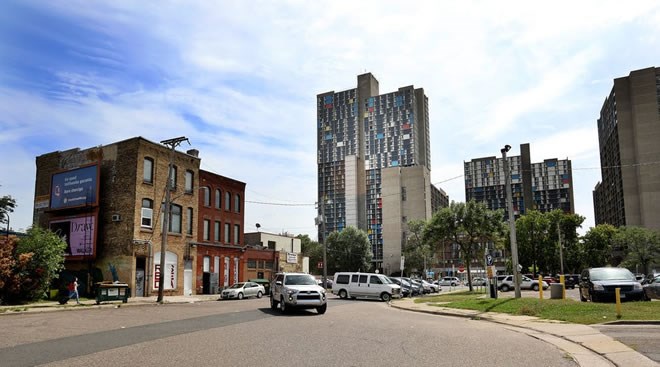
By Liz Navratil and Kim Hyatt Star Tribune
Saturday May 23, 2020

The Minneapolis Health Department, in a statement, said some of the Cedar-Riverside cases are “spread out over several high-rise buildings in the area.” David Joles - Star Tribune
At least 150 people in the densely populated, predominantly black Cedar-Riverside neighborhood in Minneapolis have tested positive for COVID-19, prompting local leaders to call for more testing and outreach.
The high number of cases — roughly 6% of the city’s total — fall in a neighborhood known for its vibrant East African community, many of whom live in high-rise apartments. The cluster raised alarms for public officials who had been watching to see if racial disparities seen in other parts of the country would play out in Minneapolis.
“I’m concerned,” said Council Member Steve Fletcher. “Anywhere that we hear about a cluster developing where there is potential for community spread, we’re concerned.”
Minneapolis health officials, citing privacy laws, would not provide further details about the cases. City Health Commissioner Gretchen Musicant attributed the number, in part, to the fact that there is “a lot more testing going on, which is good.” She referred further questions to city spokespeople.
As infection rates fall in other urban areas, the Twin Cities’ rate of coronavirus infections is standing out nationally. In a briefing Friday, White House coronavirus task force coordinator Dr. Deborah Birx identified Minneapolis, along with Washington, D.C., Baltimore and Chicago as the four metro areas in the nation where infection rates are persistent or rising.
Minneapolis had 2,339 confirmed cases as of Friday. Of those patients, 36% are black, 24% white, and 24% have their race listed as “unknown.” The race is listed as “unknown” when people decline to share their race or when they are awaiting interviews with public health authorities.
The Minneapolis Health Department said some of the Cedar-Riverside cases are “spread out over several high-rise buildings in the area.”
Both Fletcher and state Rep. Mohamud Noor, a DFLer whose district includes the neighborhood, noted that many of the people who live in Cedar-Riverside’s high-rises work in essential jobs, such as grocery stores and meat processing plants, and risk bringing the virus home to their families if they are exposed at work.
Health officials acknowledge the virus can spread that way. Minnesota state epidemiologist Dr. Ruth Lynfield said in a recent media briefing that some people who work in high-risk settings “then go to their households and there can be transmission within the community, and I think that’s what we’re seeing.”
She added, “If there is an outbreak in a particular location, it doesn’t just stay in that location, because people move.”
Both Mayor Jacob Frey and Musicant said in Friday morning’s City Council meeting that they are working with the state to try to increase COVID-19 testing in the area, aiming to do so by the end of next week.
Noor said he has pushed for increased testing and has asked state health officials for more detailed data to help guide the response. He also wants to see more help for people to isolate and get food and other necessities when they do.
Noor said he has seen firsthand what happens when COVID-19 spreads. He said his grand-uncle, who had underlying conditions, died days ago, and he knows two others who died after they contracted the disease. He said he has called ambulances for people and knows someone else in an ICU.
“You have to find basic things to support those individuals who are exposed or contracted COVID-19 so we can really tackle this pandemic,” Noor said.
“It’s not only Cedar-Riverside,” he said. “Minneapolis has got the highest rate.”
Staff writers Glenn Howatt and Jeremy Olson contributed to this report